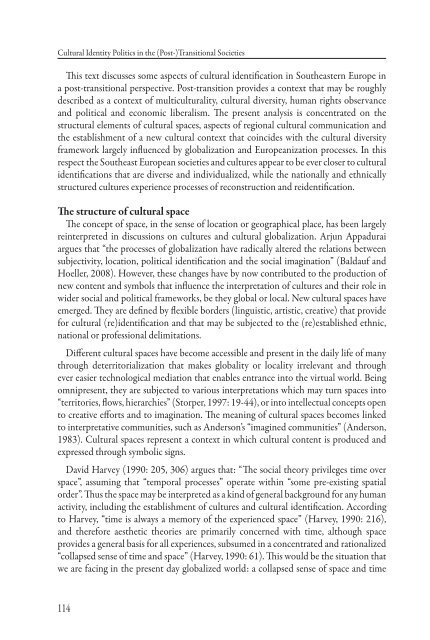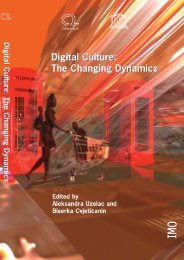free download in pdf format - Culturelink Network
free download in pdf format - Culturelink Network
free download in pdf format - Culturelink Network
You also want an ePaper? Increase the reach of your titles
YUMPU automatically turns print PDFs into web optimized ePapers that Google loves.
Cultural Identity Politics <strong>in</strong> the (Post-)Transitional Societies<br />
Th is text discusses some aspects of cultural identifi cation <strong>in</strong> Southeastern Europe <strong>in</strong><br />
a post-transitional perspective. Post-transition provides a context that may be roughly<br />
described as a context of multiculturality, cultural diversity, human rights observance<br />
and political and economic liberalism. Th e present analysis is concentrated on the<br />
structural elements of cultural spaces, aspects of regional cultural communication and<br />
the establishment of a new cultural context that co<strong>in</strong>cides with the cultural diversity<br />
framework largely <strong>in</strong>fl uenced by globalization and Europeanization processes. In this<br />
respect the Southeast European societies and cultures appear to be ever closer to cultural<br />
identifi cations that are diverse and <strong>in</strong>dividualized, while the nationally and ethnically<br />
structured cultures experience processes of reconstruction and reidentifi cation.<br />
Th e structure of cultural space<br />
Th e concept of space, <strong>in</strong> the sense of location or geographical place, has been largely<br />
re<strong>in</strong>terpreted <strong>in</strong> discussions on cultures and cultural globalization. Arjun Appadurai<br />
argues that “the processes of globalization have radically altered the relations between<br />
subjectivity, location, political identifi cation and the social imag<strong>in</strong>ation” (Baldauf and<br />
Hoeller, 2008). However, these changes have by now contributed to the production of<br />
new content and symbols that <strong>in</strong>fl uence the <strong>in</strong>terpretation of cultures and their role <strong>in</strong><br />
wider social and political frameworks, be they global or local. New cultural spaces have<br />
emerged. Th ey are defi ned by fl exible borders (l<strong>in</strong>guistic, artistic, creative) that provide<br />
for cultural (re)identifi cation and that may be subjected to the (re)established ethnic,<br />
national or professional delimitations.<br />
Diff erent cultural spaces have become accessible and present <strong>in</strong> the daily life of many<br />
through deterritorialization that makes globality or locality irrelevant and through<br />
ever easier technological mediation that enables entrance <strong>in</strong>to the virtual world. Be<strong>in</strong>g<br />
omnipresent, they are subjected to various <strong>in</strong>terpretations which may turn spaces <strong>in</strong>to<br />
“territories, fl ows, hierarchies” (Storper, 1997: 19-44), or <strong>in</strong>to <strong>in</strong>tellectual concepts open<br />
to creative eff orts and to imag<strong>in</strong>ation. Th e mean<strong>in</strong>g of cultural spaces becomes l<strong>in</strong>ked<br />
to <strong>in</strong>terpretative communities, such as Anderson’s “imag<strong>in</strong>ed communities” (Anderson,<br />
1983). Cultural spaces represent a context <strong>in</strong> which cultural content is produced and<br />
expressed through symbolic signs.<br />
David Harvey (1990: 205, 306) argues that: “Th e social theory privileges time over<br />
space”, assum<strong>in</strong>g that “temporal processes” operate with<strong>in</strong> “some pre-exist<strong>in</strong>g spatial<br />
order”. Th us the space may be <strong>in</strong>terpreted as a k<strong>in</strong>d of general background for any human<br />
activity, <strong>in</strong>clud<strong>in</strong>g the establishment of cultures and cultural identifi cation. Accord<strong>in</strong>g<br />
to Harvey, “time is always a memory of the experienced space” (Harvey, 1990: 216),<br />
and therefore aesthetic theories are primarily concerned with time, although space<br />
provides a general basis for all experiences, subsumed <strong>in</strong> a concentrated and rationalized<br />
“collapsed sense of time and space” (Harvey, 1990: 61). Th is would be the situation that<br />
we are fac<strong>in</strong>g <strong>in</strong> the present day globalized world: a collapsed sense of space and time<br />
114



